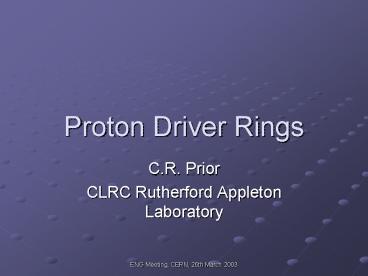Proton Driver Rings - PowerPoint PPT Presentation
1 / 27
Title:
Proton Driver Rings
Description:
SPL accumulator and compressor rings. 5 GeV, 50 Hz synchrotron ... Linac chopping. 160. No. of injection turns. 4.24. 4.35. Tunes Qh. Qv. 2. Harmonic number ... – PowerPoint PPT presentation
Number of Views:20
Avg rating:3.0/5.0
Title: Proton Driver Rings
1
Proton Driver Rings
- C.R. Prior
- CLRC Rutherford Appleton Laboratory
2
European Scenarios
- SPL accumulator and compressor rings
- 5 GeV, 50 Hz synchrotron-based system
- 15 GeV, 25 Hz synchrotron-based system
- 30 GeV, 8 Hz slow cycling synchrotron
- 8 GeV, 16.67 Hz rapid cycling synchrotron for
ISIS/Fermilab, plus upgrades
3
Design Goals
- 4-5 MW beam power on target
- Very short pulse duration (1 ns rms)
- Very low beam loss (10-4)
- Note most proton drivers under study are based
on synchrotrons (US, JKJ, UK)
4
CERN SPL Model
- Stacked accumulator and compressor rings in old
ISR tunnel, radius 151m. - H? beam from SPL cleaned of halo in
achromat/transfer line and injected via charge
exchange into accumulator
5
CERN Proton Driver Accumulator Compressor
(PDAC) Rings
- Protons accumulated over 660 revs of machine (2
ms) - Then transferred to compressor. In 8 revs under
8 MV of RF beam rotates in longitudinal phase
space to give 3 ns rms bunch duration at pion
target. - Injection foil heating looks to be a severe
problem.
6
CERN PDAC Accumulation of beam
7
CERN PDAC Accumulation of beam
8
CERN PDAC Bunch Compression
9
Synchrotron-based Proton Drivers
- Low energy linac (150 MeV)
- Booster synchrotrons to accumulate proton beam
and perform some acceleration - Main synchrotrons to complete acceleration and
compress the bunches.
10
RAL 5 GeV Proton Driver
11
Booster Synchrotrons 180 Mev to 1.2 GeV
12
160 injection turns injection period
0.2ms Number of particles per bunch 2.5 1013
13
Betatron and dispersion
Orbit bump, momentum ramping and RF steering
14
Main Synchrotron 1.2 to 5 GeV
Radius 65m Operating at 25Hz Accelerate beam and
carry out ns bunch compression
Simple FODO lattice with dispersion designed to
keep ?t unchanged under high levels of space
charge
15
Longitudinal Simulationshowing 1ns bunch
compression
16
Voltage Requirements
17
RAL 15 GeV Scheme
- Frequency 25 Hz
- Booster synchrotrons accumulate beam at 180 MeV
and accelerate to 3 GeV - Main synchrotrons accelerate to 15 GeV and
perform bunch compression - Total beam power 4 MW
18
Booster Synchrotrons
3 bunches each of 1.1 1013 protons
19
Main Synchrotrons
20
ISIS MW Upgrades and possible use as a NF test bed
- 800 MeV,160 kW, 50 Hz, spallation neutron source
- Current upgrade to 240 kW with new ion source,
RFQ and dual harmonic RF accelerating system
21
Stage 1 upgrade to 1MW neutrons
- Addition of a new synchrotron to increase beam
energy to 3 GeV at 50 Hz - Operated at 16.67 Hz, with every third ISIS
pulse, could take beam to 8 GeV and be used as a
test bed for 1 ns bunch compression
22
ISIS Upgrade Lattice
- Mean radius 78 m, 3 x ISIS
- Racetrack lattice, h6 or h12
- Long dispersion-free straights for injection, RF
and extraction - Top energy ?9.5 lt ?t13.8
- Qh11.7, Qv7.32 avoid serious resonances
- Chromaticity correcting sextupoles
- Good dynamic aperture (500 mm.mrad)
With slight modifications, this lattice was
chosen for Fermilab Proton Driver Study II
23
Stage 2 Upgrade to 4-5 MW
- Design and build new linac and two new booster
synchrotrons with radius 39 m, operating at 50 Hz
to 1.6 GeV (h3) - Build a second 78 m racetrack
- Operate the two racetracks at 25Hz on alternate
cycles - 2MW beam power in each rings
- 4MW neutron source
- 2MW to neutron target
- 2MW to pion target
- 4MW to pion target
180 MeV Linac
39m radius
78m radius
24
Proton Driver Figure of Merit
- For a given power (4MW), target peak proton power
density 1/(Kinetic energy T x frequency f).
FT?f is a useful figure of merit.
25
Accelerator RD
180 MeV Linac
- Linac for synchrotron models based on ESS front
end - RD for ion source generating 60 mA H?
- 280 MHz RFQ development
- Development with industry of 280 MHz IOT power
supplies - Construction and test of a beam chopper (RAL in
parallel with CERN) - Design of a 200 MeV DTL
RF Quadrupole
Drift tube linac 1
Drift tube linac 2
Ion source
2.5 MeV Chopper
20 MeV
180 MeV
Common to ESS
New
RF Frequency 280 MHz
26
2.5 MeV Fast Beam Chopper
27
Milestones?
- Milestones cannot be set without manpower
- There is currently no group working on rings
aspects of proton drivers for NF in Europe - The only effort is aimed at an ISIS spallation
neutron source upgrade - Proton drivers are not peculiar to NF and RD
should not be tied to ENG































